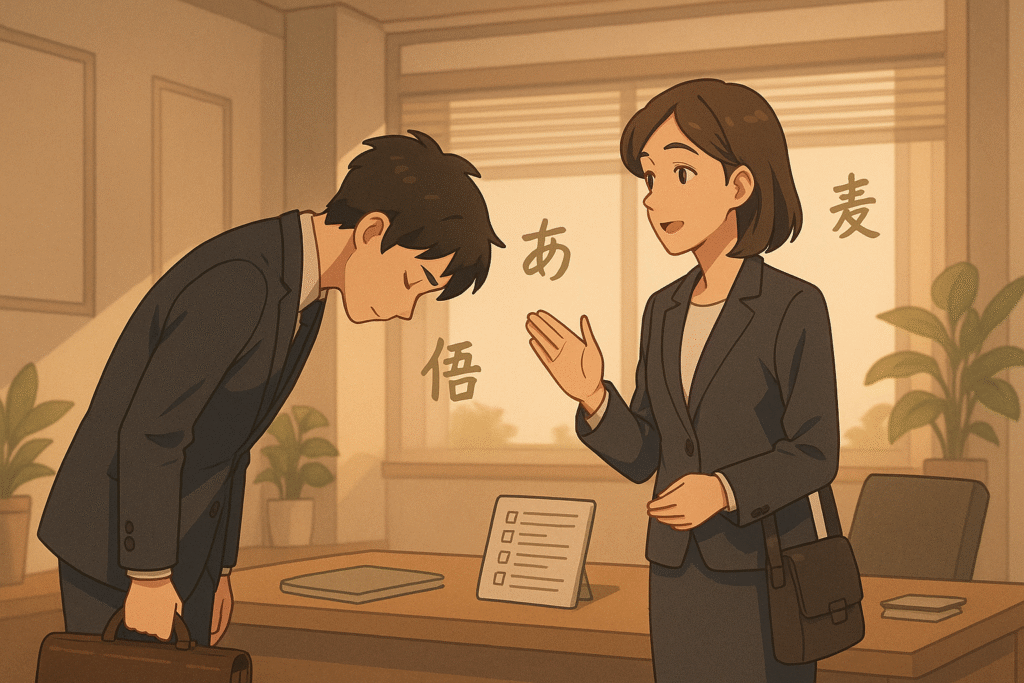Have you ever watched anime or Japanese dramas and noticed characters frequently saying “gomenasai” when they make mistakes? Understanding the gomenasai meaning and when to use it appropriately is essential for anyone learning Japanese or planning to visit Japan. This simple yet nuanced expression is a cornerstone of Japanese communication and politeness.
In this comprehensive guide, we’ll explore everything you need to know about the gomenasai meaning, how it compares to other Japanese apology expressions, and when to use each one correctly. By the end, you’ll be able to apologize naturally and appropriately in any Japanese social situation.
What Is the Gomenasai Meaning in Japanese?
At its core, the gomenasai meaning in Japanese is “I’m sorry” or “I apologize.” This common expression derives from the word “gomen” (御免), which historically meant “your permission” or “your pardon,” combined with “nasai,” which is a polite command form. Together, gomenasai (ごめんなさい) has evolved to become one of the standard ways to apologize in Japanese.
The gomenasai meaning encompasses feelings of regret, apology, and a desire to maintain harmony in relationships. In Japanese culture, where maintaining smooth social interactions is highly valued, knowing how and when to apologize appropriately is considered an essential social skill.
Gomenasai vs. Sumimasen: Understanding the Key Differences
One of the most common sources of confusion for Japanese learners is understanding when to use “gomenasai” versus “sumimasen.” Both expressions convey apology in Japanese, but they have distinct nuances and social applications.
When to Use Gomenasai:
The gomenasai meaning is best suited for:
- Personal and casual settings – With friends, family members, and people you’re close to
- Genuine mistakes or wrongdoings – When you’ve done something that requires a straightforward apology
- Informal situations – In relaxed, non-business environments
When to Use Sumimasen:
“Sumimasen” (すみません) is more appropriate for:
- Formal or public settings – In businesses, with strangers, or in public spaces
- Getting someone’s attention – As a polite “excuse me”
- Expressing gratitude with a sense of apology – When someone has gone out of their way for you
Similar to how we discussed the nuances of using “wakarimasen” in another article, understanding these subtle differences is crucial for natural-sounding Japanese.
Gomenasai Meaning in Different Forms: Casual to Formal
The gomenasai meaning changes slightly depending on which form you use. Japanese apologies exist on a spectrum from very casual to extremely formal. Here’s a breakdown:
Casual Forms:
- Gomen (ごめん) – Very casual, used only with close friends and family
- Gomen ne (ごめんね) – Casual but softer, adding a touch of friendliness
Standard Forms:
- Gomenasai (ごめんなさい) – Standard polite form, suitable for most situations
Formal Forms:
- Moushiwake arimasen (申し訳ありません) – Very formal, used in business settings or with superiors
- Taihen moushiwake gozaimasen (大変申し訳ございません) – Extremely formal, for serious mistakes in business contexts
Just as we explored the levels of politeness with “minasan”, the degree of formality in Japanese apologies reflects your relationship with the listener and the severity of the situation.
Real-Life Examples of Gomenasai in Context
To truly grasp the gomenasai meaning in practice, let’s look at some common scenarios where different forms of apology would be appropriate:
Example 1: Casual Apology to a Friend
Situation: You’re 10 minutes late meeting a friend for coffee.
Japanese: ごめんね、ちょっと遅れちゃった。 Romaji: Gomen ne, chotto okurechatta. English: Sorry, I’m a bit late.
Why this form: With a friend, the casual “gomen ne” feels natural and appropriate.
Example 2: Standard Apology in Daily Life
Situation: You accidentally bump into someone at the train station.
Japanese: あ、ごめんなさい。 Romaji: A, gomenasai. English: Oh, I’m sorry.
Why this form: For strangers in public places, the standard “gomenasai” is polite without being overly formal.
Example 3: Formal Apology in a Business Context
Situation: You made an error in a report submitted to your boss.
Japanese: 報告書に間違いがあり、申し訳ありません。 Romaji: Houkokusho ni machigai ga ari, moushiwake arimasen. English: I apologize for the mistake in the report.
Why this form: In a business setting with a superior, the formal “moushiwake arimasen” is appropriate.
Cultural Context: The Importance of Apologies in Japanese Society
The gomenasai meaning extends beyond just the words – it’s deeply embedded in Japanese cultural values. Understanding this cultural context helps you grasp why apologizing correctly is so important in Japan.
In Japanese society, maintaining harmony (和 – wa) is considered essential. Apologizing, even for minor issues or sometimes when you haven’t done anything wrong, helps preserve this harmony. This practice might seem excessive to people from Western cultures, but in Japan, it’s an integral part of smooth social functioning.
Just as with “so desu ka”, which we explored in a previous article, understanding cultural context is vital for using Japanese expressions naturally.
Want to explore Japan’s culture?
Discover Japan’s rich culture, traditions, and hidden gems with our expertly crafted guides. Get insider tips on travel, food, and history. All for free!
Body Language and Tone When Expressing Gomenasai
The gomenasai meaning is conveyed not just through words but also through appropriate body language and tone. Here are some key points to remember:
- Bowing – A slight bow often accompanies apologies. The deeper the bow, the more sincere or formal the apology.
- Tone of voice – For “gomenasai,” a genuinely apologetic tone works best. For casual “gomen,” the tone can be lighter.
- Facial expression – Your expression should match the seriousness of the situation. A slight look of concern is appropriate for standard apologies.
Understanding these non-verbal aspects helps communicate the full gomenasai meaning in authentic Japanese interactions.
Tips for Mastering Japanese Apologies
To use gomenasai and other apology expressions naturally in Japanese, consider these practical tips:
- Match the formality to the situation – Consider your relationship with the person and the setting.
- Learn set phrases for specific situations – For example, “Okurete gomenasai” (遅れてごめんなさい) for “Sorry I’m late.”
- Don’t overuse the most casual forms – Save “gomen” for close friends and family.
- When in doubt, err on the side of more polite – It’s better to be slightly too formal than too casual.
- Listen to native speakers – Pay attention to which forms Japanese people use in different contexts.
If you’re serious about mastering these nuances of Japanese communication, our comprehensive Japanese learning guides offer free resources to help you on this journey.
Conclusion: The Importance of Understanding Gomenasai Meaning
Mastering the gomenasai meaning and knowing when to use different Japanese apology expressions is a significant step toward communicating naturally in Japanese. While the basic translation is “I’m sorry,” the cultural nuances, appropriate contexts, and variations in formality make this seemingly simple phrase rich with meaning.
Remember: Gomenasai means “I’m sorry” in Japanese and is used primarily in casual to semi-formal settings.
By understanding when to use gomenasai versus alternatives like sumimasen or more formal apologies, you’ll navigate Japanese social interactions with greater confidence and cultural sensitivity, avoiding potential awkwardness or misunderstandings.
Q&A: Common Questions About Gomenasai Meaning
Q: Is gomenasai formal or informal?
A: Gomenasai falls in the middle of the formality spectrum. It’s more formal than “gomen” but less formal than “moushiwake arimasen.” It’s appropriate for everyday situations with people you don’t know well.
Q: Can I use gomenasai in business settings?
A: Generally, no. In business settings, especially with superiors or clients, “moushiwake arimasen” is more appropriate. Gomenasai is usually too casual for professional environments.
Q: What’s the difference between “gomen” and “gomen ne”?
A: “Gomen” is the most casual form of apology. Adding “ne” softens it slightly and adds a touch of friendliness or empathy. Both are only appropriate with people you’re close to.
Q: Should I bow when saying gomenasai?
A: A slight bow is appropriate when saying gomenasai. The depth of the bow generally corresponds to the seriousness of the situation and the formality of the apology.
Q: When should I use sumimasen instead of gomenasai?
A: Use sumimasen in public or formal situations, especially with strangers or in business contexts. It’s also appropriate when you want to get someone’s attention politely.
Ready to take your Japanese learning to the next level? Discover more language insights and practical communication tips with our free Japanese learning resources today!
Love Japan? Stay in the Loop!
Get the best of Japan straight to your inbox: language, culture & travel insights!




